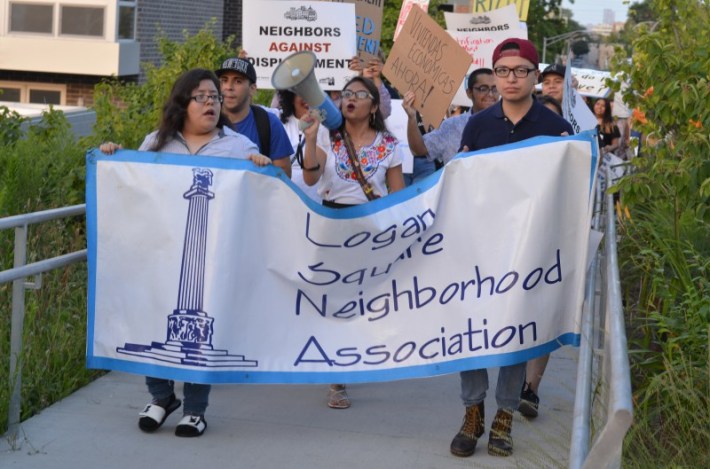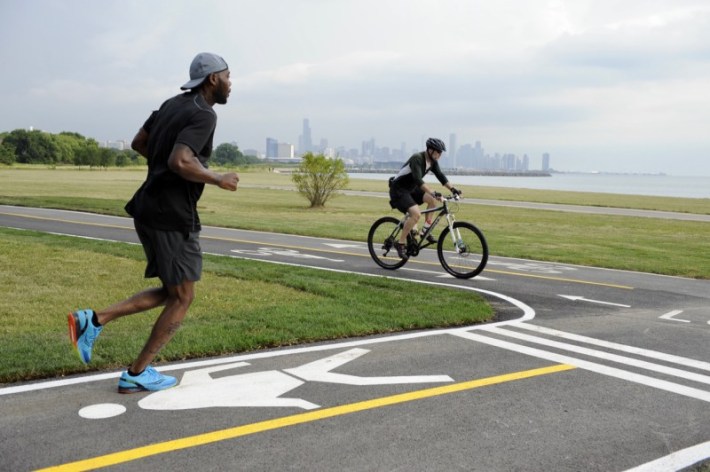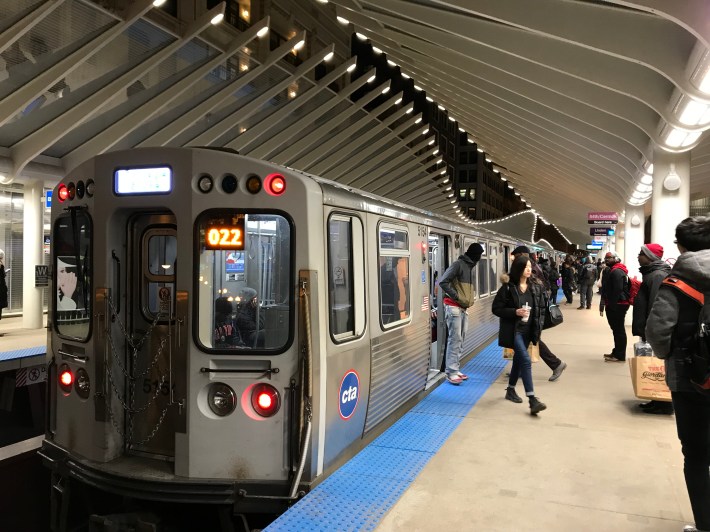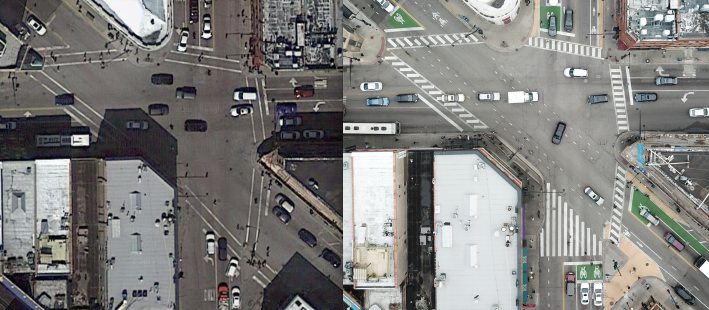As we close out 2017 here at Streetsblog Chicago, we thought we’d celebrate the upside of a generally rotten year in the United States by highlighting some of the more positive things that happened in Chicago transportation in 2017.
Vote on your favorite new developments in the local livable streets scene, one vote per category. Did we overlook anything? Let us know in the comments section.
The site will be on vacation next week, but we’ll announce the results in the new year. Have a safe and joyous holiday season, and we’ll see you in 2018.
Best New Transportation-Related Policies

The 606 affordability ordinance
In response to skyrocketing home prices along the western half of the Bloomingdale Trail corridor, in May affordable housing organizations and local aldermen introduced the Pilot Act for the Preservation of Affordable Housing in the 606 Residential Area, which would charge an additional fee of between $300,000 and $650,000 for teardowns, as well as a fee for enlarging existing buildings, which would be used to fund affordable housing in the area. The legislation has been languishing at City Hall, but advocates say they’ll keep pushing to make it happen.
The truck side guard ordinance
In 2016 four young people on bikes in Chicago and Evanston were killed when they were crushed beneath the wheels of trucks. In the wake of these tragedies, advocates called on Chicago leaders to enact a law requiring safety mirrors and side guards – which prevent cyclists and pedestrians from falling under the wheels – to be installed on large trucks. In July of this year aldermen passed an ordinance mandating the safety gear for all trucks over 10,000 pounds used by any business with a city contract worth $2 million or more. They also earmarked $5 million to retrofit 1,700 city vehicles. The legislation isn’t perfect, since it doesn’t apply to all large trucks and loopholes allow contractors to delay installation, but it will still help save lives.
The new ride-hailing fee to fund the CTA
Recent studies have proven what was long suspected: Ride-hailing services like Uber and Lyft are increasing traffic congestion in cities and cannibalizing transit ridership. In response, last month City Council approved a 15-cent surcharge to the existing city ride-share fee of 52 cents per trip, with the additional revenue earmarked for CTA infrastructure. The new tax will be raised 20 cents, to 72 cents total, in 2019. The fee is projected to raise $16 million for the transit agency next year, with $21 million expected in 2019, which should go a long way towards leveling the playing field.
Best New Bike Infrastructure

The Glenwood Greenway
The great thing about this neighborhood greenway project in Uptown and Edgewater is that it took and already-popular cycling route and made it safer and more convenient. Opened in May, this $65,000 initiative includes a southbound contraflow bike lane on Glenwood from Ridge to Foster, plus a concrete island at Ridge, sharrows, and safety and wayfinding signs. This created a low-stress north-south route that’s a great alternative busy Clark and Broadway.
The North Branch Trail extension
Despite opposition from some nearby residents, this summer the Cook County Forest Preserve District extended this popular greenway four miles miles further south into the city, from Devon/Caldwell in Edgebrook to Foster/Kostner in North Mayfair. This $7.7 million project, which includes several nifty underpasses and overpasses, make it easier than ever for city dwellers to pedal to the Chicago Botanic Gardens in Glencoe.
Lakefront Trail separation
A year ago, after emailing Mayor Emanuel to complain that our city’s shoreline path was in terrible shape, Republican hedge fund billionaire Ken Griffin was persuaded to donate $12 million to the Chicago Park District to build separate paths for pedestrians and cyclists along virtually all of the 18.5-mile trail. We can debate whether it’s a good idea for Chicago to pay for transportation infrastructure with a gift from the man who’s the largest outside donor to Governor Bruce Rauner, who has overseen cuts to Chicago-area transit funding. But the project is moving along nicely – separation is already competed between 31st and 41st streets, between Fullerton and North avenues, and between Oak and Ohio streets, with the rest of the work slated to wrap up in 2018.
Best New Transit Facility

The new Washington-Wabash station
Haters may call it a Calatrava clone, but this ‘L’ stop, which opened in August on Jeweler’s Row, is in the running for the CTA’s most beautiful facility. The $75 million structure, reminiscent of a whale’s skeleton, is first new CTA train stop to open downtown in two decades. It replaces the Madison/Wabash and Randolph/Wabash stations, which were built over 120 years ago, and it’s expected to become one of the system’s top ten busiest rail stations, providing more than 10,000 rides per day on the Brown, Green, Orange, Pink and Purple Lines.
The Wilson station reconstruction
The $203 Wilson station rehab is turning of the CTA’s gnarliest stops into a new centerpiece for the Uptown community, complete with the first-ever elevators, escalators, and wheelchair ramps, a dazzling art installation in the main entrance on the south side of Wilson, and has turned the stop into a transfer between the Red and Purple lines. A brand new entrance on Sunnyside opened earlier this month and the rest of the project, including the full restoration of the 1923 Gerber Building on the north side of Wilson, is supposed to wrap up in January.
The 95th Street station rehab
Work began on this $280 million project in fall 2014 to improve one of the CTA’s busiest stations, which serves the Red Line and many CTA, Pace, and intercity bus lines, and serves about 20,000 riders per day. A new south terminal is currently being built, with work scheduled to wrap up early next year, and the north terminal renovation is slated for completion in late 2018. The new station will include art by Chicago-based artist Theaster Gates, and officials have promised it will be “bright, airy, and light-filled.”
Best None-of-the-Above

Milwaukee Ave. upgrades in Wicker Park / Bucktown
This summer the Chicago Department of Transportation completed a $253,000 redesign of the “Hipster Highway,” partly funded by Divvy revenue, using street paint and plastic posts to do “quick-hit” improvements. Highlights include new experimental “dashed bike lanes” on a stretch of Milwaukee that’s too narrow for conventional lanes, lots of sidewalk bump-outs to shorten crossing distances, and the closure of dangerous slip lanes. The North/Damen/Milwaukee “Crotch” got four new green-painted bike boxes and a giant crosswalk. Now if only all motorists would respect these new features…
Equiticity launches, starts bike libraries
Equiticity, the new mobility justice group, started last month by Slow Roll Chicago cofounder Oboi Reed, is partnering on the bike library project with We Keep You Rollin’ a bike group in the Riverdale community area (which includes Altgeld Gardens, Golden Gate and other enclaves) led by Deloris Lucas, and several community groups in North Lawndale. The Beijing-based dockless bike-share company Ofo has promised to donate at least 100 cycles, possibly as many as 300, for the Riverdale library, and Jump Mobility, an electrical-assist dockless bike purveyor from New York, has pledged 100 cycles for the North Lawndale library. Each company has already delivered a small number of bikes for test rides by residents, and the full libraries are slated to launch in early April.
Chicago Critical Mass celebrates 20 years of monthly rides
…Or 30 years, according to some wiseacres who printed that on t-shirts for the massive anniversary ride in September. The rolling party / protest for safer streets draws hundreds of people to Daley Plaza on the last Friday of every month for a relaxed cruise through the neighborhoods, leaving the plaza around 6 p.m. Chicago Critical Mass has helped push for better bike infrastructure and launched countless careers in bike advocacy and planning, a fact that was acknowledged in a blog post from the Active Transportation Alliance.




